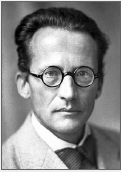What the Schroedinger theory doesn’t do is provide us with a physical interpretation for the value of the wave function Ψ at any particular location and time. Because it involves imaginary numbers, we can’t expect to assign any measurable property to Ψ anyway, so maybe it is just as well. Wave functions can be deduced from the math, but what do they represent? And, for that matter, what good are they anyway?
For starters, as Max Born showed, the square of the amplitude of the wave function at a certain location can be interpreted as the probability that the particle exists at that location in the first place. It should be clear, then, that a particle’s wave function provides some sort of statistical information about the particle. Quantum mechanics provides us with a way of milking that statistical information to learn more about the particle than just its likelihood of appearing at any point in space.
For example, individual measurements of particle position will yield a range of differing results. The statistical average of a large number of such measurements is something we call the expectation value of the position (since that’s where you could “expect” to find the particle with any random measurement). If you know the mathematical form of a wave function, you can determine the expectation value independently of the measurements using standard mathematical techniques for expectation values. But Schroedinger’s equation does not predict the exact result of any individual measurement.
QUANTUM QUOTE
It would have been beautiful if you were right. Something that beautiful happens, unfortunately, seldom in this world.
—Max Born, developer of a competing version of quantum mechanics, to Erwin Schroedinger
In the Schroedinger formalism, the concept of expectation values is easily extended from position to other physical quantities (like energy or angular momentum). The details need not concern us here, but the wave function can also be used with other standard mathematical operations to yield expectation values for these quantities. For this reason, it can be said that all of the information that exists about a particle is contained in its wave function. All, of course, that is allowed by the uncertainty principle.
Each time an operation is applied to determine an expectation value, the mathematical operations result in real numbers. This is important, since only real quantities can be measured in the laboratory. What, then, does the imaginary component bring to the table? Well, the complex nature can be thought of as the “phase” of the wave function. This phase aspect is needed to produce diffraction and other interference effects. In and of itself, though, it can never be directly observed.

ERWIN SCHROEDINGER
Erwin Schroedinger was born in Vienna in 1887. Though regarded throughout his career as a gifted and versatile physicist, he managed to make it into his late thirties before making his first significant contributions to the field. In 1925, two years shy of his fortieth birthday, he happened upon an Einstein footnote praising the work of de Broglie. This initiated a quest to understand the full significance of matter waves. His famous wave equation emerged during a two-week holiday in a Swiss Alpine villa one year later.
Schroedinger came of age in the years before quantum physics. He was therefore a classical physicist in quantum physicist’s clothing, who aspired through his wave mechanics to restore certain classical features that had been lost. In particular, he was determined to do away with the profoundly nonclassical notion of quantum jumps, deemed in his characteristically blunt manner as “nonsense.” He failed in this regard, but not without debating Bohr and Heisenberg endlessly on the subject.
Schroedinger had both a profound intellect and a wide-ranging curiosity. In addition to inventing wave mechanics, he mastered Western languages, examined Greek science and philosophy, and translated German humorists into English. What’s more, his charming 1944, What is Life, is still credited with helping lay the foundations of modern biology.
Leave a Reply